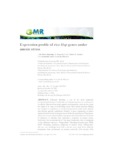Por favor, use este identificador para citar o enlazar este ítem:
http://www.alice.cnptia.embrapa.br/alice/handle/doc/1058201Registro completo de metadatos
| Campo DC | Valor | Lengua/Idioma |
|---|---|---|
| dc.contributor.author | MERTZ-HENNING, L. M. | pt_BR |
| dc.contributor.author | PEGORARO, C. | pt_BR |
| dc.contributor.author | MAIA, L. C. | pt_BR |
| dc.contributor.author | VENSKE, E. | pt_BR |
| dc.contributor.author | ROMBALDI, C. V. | pt_BR |
| dc.contributor.author | OLIVEIRA, A. C. de | pt_BR |
| dc.date.accessioned | 2017-07-13T18:49:40Z | - |
| dc.date.available | 2017-07-13T18:49:40Z | - |
| dc.date.created | 2016-12-07 | pt_BR |
| dc.date.issued | 2016 | pt_BR |
| dc.identifier.citation | Genetics and Molecular Research, v. 15, n. 2, gmr.15027954, may 2016. | pt_BR |
| dc.identifier.issn | 1676-5680 | pt_BR |
| dc.identifier.uri | http://www.alice.cnptia.embrapa.br/alice/handle/doc/1058201 | pt_BR |
| dc.description | ABSTRACT: Although flooding is one of the most important environmental stresses worldwide, not all plant species are intolerant to its effects. Species from semi-aquatic environments, such as rice, have the capacity to cope with flooding stress. Heat-shock proteins (Hsps) are thought to contribute to cellular homeostasis under both optimal and adverse growth conditions. Studies of gene expression in plants exposed to low levels of oxygen revealed the up-regulation of Hsp genes. However, it is not clear whether Hsp genes are transcribed as a function of tolerance or whether they represent a response to anoxic stress. Therefore, the accumulation of Hsp gene transcripts was investigated in two different cultivars, 'Nipponbare' (flooding tolerant) and 'IPSL 2070' (flooding sensitive), subjected to anoxic stress. Fifteen-day-old rice root seedlings from both cultivars were used. Four different treatments were performed: no anoxia (control); 24-h anoxia; 48-h; and 72 anoxia; and 72-h anoxia. Anoxic stress was confirmed by the increased gene expression of alcohol dehydrogenase. The data obtained showed that both rice cultivars ('Nipponbare' and 'IPSL 2070') accumulated Hsp gene transcripts under anoxic stress; however, the majority of the Hsp genes evaluated were responsive to anoxic stress in 'IPSL 2070' (flooding sensitive), whereas in 'Nipponbare' (flooding tolerant), only six genes were highly up-regulated. This suggests that although Hsps have an important role in the response to anoxia, they are not the major cause of tolerance. | pt_BR |
| dc.language.iso | eng | eng |
| dc.rights | openAccess | eng |
| dc.title | Expression profile of rice Hsp genes under anoxic stress. | pt_BR |
| dc.type | Artigo de periódico | pt_BR |
| dc.date.updated | 2017-07-13T18:49:40Z | pt_BR |
| dc.subject.thesagro | Arroz | pt_BR |
| dc.subject.thesagro | Gene | pt_BR |
| dc.subject.nalthesaurus | Rice | pt_BR |
| dc.subject.nalthesaurus | Gene expression | pt_BR |
| riaa.ainfo.id | 1058201 | pt_BR |
| riaa.ainfo.lastupdate | 2017-07-13 | pt_BR |
| dc.identifier.doi | http://dx.doi.org/10.4238/gmr.15027954 | pt_BR |
| dc.contributor.institution | LILIANE MARCIA MERTZ HENNING, CNPSO; UFPel; UFPel; UFPel; UFPel; A. Costa de Oliveira, UFPel. | pt_BR |
| Aparece en las colecciones: | Artigo em periódico indexado (CNPSO)  | |
Ficheros en este ítem:
| Fichero | Descripción | Tamaño | Formato | |
|---|---|---|---|---|
| Expressionprofile....pdf | 1,55 MB | Adobe PDF |  Visualizar/Abrir |









